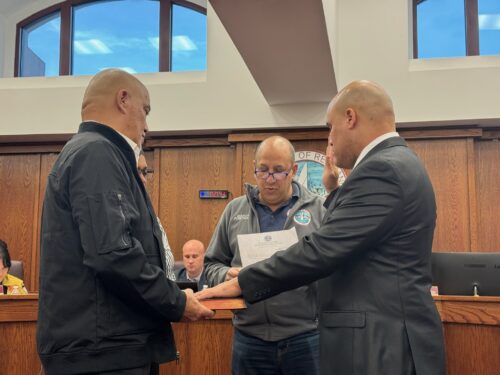Say goodbye to those Cushmans.
Last month, the Red Bank Borough Council authorized the purchase of two Club Car Carryall 2 electric vehicles from golf-cart seller Vic Gerard Golf Cars. They’ll replace a pair of gas-powered Cushman three-wheelers used by Parking Utility enforcers. Price: $13,750 each.
The purchase is part of an effort by elected officials including last year’s mayoralty rivals Pasquale Menna (who won) and John Curley (who didn’t, but remains on the council) to begin paring the borough fleet of gas guzzlers and replacing them with energy-efficient vehicles.
While small-scale, it’s a move that reflects what appears to be a big change in the public’s thinking about the environment. In fact, we may be living in history’s ‘greenest’ moment since the dawn of the Industrial Revolution.
So here’s a question or two inspired in part by the borough’s purchase: would electric cars make sense on the consumer side as well? Is it too soon to dream of the day that our compact, 1.8-square-mile burg might buzz with quiet, compact, no-emissions cars that their owners plug in at night to recharge?
redbankgreen got a chance to try out an electric car for a week or so recently, courtesy of Remsen Straub, a Lincroft resident who owns Remsen Dodge in Hazlet. Straub had come across this website earlier this year and thought we should test drive one of the new “Neighborhood Electric Vehicles” that he’s selling.
We weren’t familiar with NEVs. Straub explained that New Jersey last year passed a law permitting the use of low-speed, non-gasoline-burning vehicles on roads with posted speeds of 35 mph or lower, as long as those vehicles were designed never to exceed 25 mph. They’re registered and insured just like other cars. (The state’s rules governing what it calls Low Speed Vehicles are here.)
There are a number of manufacturers in the NEV business now, and Straub represents four of them (including Zenn and Kurrent), but the car we got was the GEM e2, made by Global Electric Motors, a subsidiary of DaimlerChrysler. It starts at about $9,000.
Our test car arrived on a flatbed truck looking like a gleaming new toy: egg-shaped profile, stubby wheels, a pug nose (complete with a faux grill), and a chromed cargo deck out back. In the center of the grill was a cap covering the connector to the extension cord we’d use to charge the batteries overnight.
Right away, we named it “Sparky.”
Its limitations were numerous, it should be said at the outset.
Though doors are available, this one came without them, and there was no rear windshield. Hence, you needed a towel to remove dew or rainwater from the seats. But there was no place to store a towel when you weren’t using it. In fact, except for the open-air cargo bin and some cupholders, there wasn’t anyplace to put much of anything. You had to sit on, or buckle in, your valuables, lest they slide right through the opening where the passenger door should have been. (We gave Joyce Williams of the Westside Community Group a ride home one night, and she held some folders she’d been carrying down on the floor with one foot.)
Then there are the big drawbacks: lack of speed and short operating range between charges. Even under ideal conditions, Sparky would only be able to travel about 30 miles on a full battery charge, which takes about 8 hours.
On the plus side, it sips electricity from a common household connection.
But driving Sparky around, and letting other people do the same, turned out to be a ticklish experience. We were surprised by the pep it showed in going from a dead stop to its top, blazing speed, it’s battery-powered motor whirring earnestly. And we loved how other people seemed to love seeing it.
“Isn’t that a hoot?” Pat Ellson said after she took Sparky for a spin. (That’s Pat in the photo at the top of this story.) Though she moved out of town to Eatontown two years ago, she said she could imagine driving an electric car to do her shopping at Sickle’s Market.
Everywhere we went, we’d get horn honks and encouragement from other motorists and pedestrians. One woman pronounced it “the cutest thing ever,” and shouts of “nice wheels” were frequent. Once, waiting for the light to change at Monmouth Street and Maple Avenue, we got into a conversation with an admiring passenger in a Jeep Cherokee.
“If I had a dollar for every time a kid yelled ‘nice ride’ to me,” says Ken Pringle, “I’d buy another one.”
Pringle is the mayor of Belmar and Red Bank’s borough attorney. He’s also perhaps the New Jerseyan most responsible for persuading the state Legislature to adopt the law that enabled the use of NEVs here, a crusade he embarked on several years ago after he bought a GEM four-seater on eBay. It quickly became known as ‘the Mayormobile.’
Because of Pringle’s efforts (and because he leased his car to the town for $1), Belmar has been at the NEV forefront in New Jersey, and has a terrific web page on the topic. Today, the borough police department has three two-seaters.
Pringle understands the infatuation some people feel for these cars; he’s never lost his own. “My saddest day of the year is the day it gets too cold and I have to put it in the garage and winterize it,” he tells redbankgreen. “And one of my favorite days is when I get to pull it out again.”
After just a day or too, we were hooked on Sparky. But we recognize that our circumstances living and working in town, and having the ability to switch to conventional cars to travel greater distances made us better suited to the technology than folks who have to get on a highway every day.
Becoming familiar with Sparky, though, meant finding out some things about his heritage that kind of shocked us. We rented a documentary that came out last summer, called “Who Killed the Electric Car?” [Trailer]
The film is jaw-dropping. It’s about the brief rise and mysterious disappearance of highway-ready electric cars in the late 1990s. By then, the major car manufacturers had pretty much perfected useful, medium-range, fast electric cars, and hundreds made by General Motors, Toyota and others were leased (rarely, if ever, sold) to customers throughout California, which in the early 1990s had adopted a zero-emissions mandate for two percent of all cars sold there.
But fearful, apparently, that the mandate might be increased, the manufacturers and the Bush administration got it quashed. Immediately afterward, the automakers repossessed all the cars, and this must be seen to be believed destroyed them in the Arizona desert. The New York Times called the film “an inducement to rage.”
Watching the footage of decade-old cars that looked more like sports cars than golf carts zipping down the 404 made us realize what a step back in time Sparky was, rather than a great leap forward.
Still, the good news is that the electric vehicle is coming back from the dead, and the GEM e2 is part of that, however modest. Zenn has a model that looks more like a conventional car, and Kurrent has one that’s the height of styling. Other manufacturers are dreaming big. Tesla Motors has a roadster nearing production that it claims can accelerate from 0-60 mph in about 4 seconds, reach a top speed of over 130 mph and travel more than 200 miles on a single charge of its lithium ion batteries. The cars are expected to be available this summer, at a sticker price of $92,000.
Great leaps forward in battery life are also forecast to occur in the next couple of years.
But that’s the future. For now, except for pioneers like Pringle and Metrovation partner Chris Cole, who lives in Red Bank and also owns a GEM e2, it’s hardly a movement. Moreover, there’s resistance in some places. Tinton Falls recently banned the use of NEVs everywhere except on private property, a move that Remsen Straub says is shortsighted.
But Belmar is being proactive, hoping to expand the use of electric vehicles throughout town. Pringle’s pushing a “station car” program under which employers would buy electric cars and keep them at train stations for the use of commuting employees. (New Jersey Transit on whose board Pringle sits is planning a pilot program for Rahway with Merck & Co.) Belmar also hopes to make the cars available at the muncipal marina for visiting boaters to use as courtesy cars.
And it’s not only about getting people around in environmentally friendly fashion. NEVs are also effective at calming traffic in Belmar, where Pringle says speeding is the number-one complaint. “I see them as moving speed bumps,” Pringle says of the cars. “If you put dozens if not hundreds of these vehicles out on the street, it will bring traffic down to a speed that’s enjoyable by everybody.”
Red Bank, says Pringle, “is an ideal town” for NEVs. He envisions a day not too far in the future when they’re “fabulously popular” here.
We do, too. For now, though we miss the only NEV we’ve ever known. Come back, little Sparky!
























